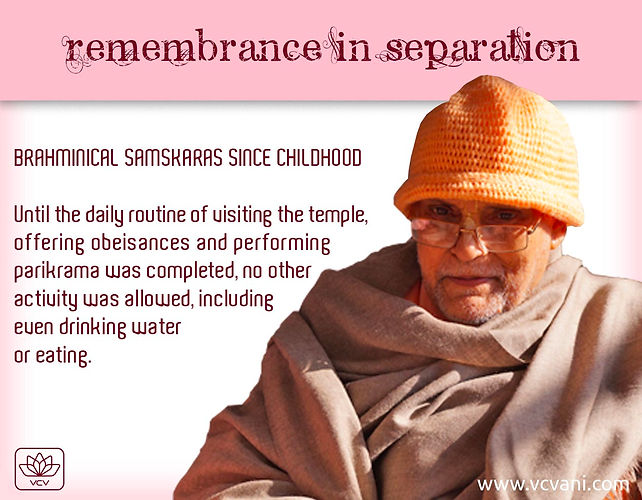Childhood and Receiving Brāhmiṇical Saṁskāras
- Remembrance in Separation - Bhagavata Patrikā
- Jun 20, 2019
- 2 min read

Śrī Śrīmad Bhakti Vijñāna Bhāratī Gosvāmī Mahārāja appeared in an exceedingly affluent and aristocratic Cakravartī brāhmaṇa family on the auspicious tithī of Śrī Śayana Ekādaśī in Sītā-Rāmapura village (Bankurā District, West Bengal) on July 21, 1926 to his parents, Śrī Vanamāli Cakravartī and Śrīmati Prabhāsa Manjarī Cakravartī. Although Śrīla Mahārāja’s parents and family members were disciples of a gosāī (from Nākāījoḍī, Viṣṇupura) in the lineage of Śrīnivāsa Acārya, brāhmiṇical principles were given more precedence in his family. Thus, Śrīla Mahārāja received brāhmiṇical saṁskāras right from his childhood.
Śrīla Mahārāja would allude to his childhood in certain contexts. Once, he said, “From the time I became old enough to discern, I can recall, that every morning after bathing, etc., it was mandatory to first visit the temple [in the residential premises], offer obeisances and perform parikramā, regardless of whether we had to go to school. Until this routine was completed, no other activity was allowed, including even drinking water or eating. Upon entering the temple, after offering obeisances to Śrī Gadhādhara śilā, the following śloka had to be chanted -
śāntā-kāraṁ bhujaga-śayanaṁ padmanābhaṁ sureśam
viśva-dhāraṁ gagana-sadṛśaṁ megha-varaṇaṁ shubhāṅgam|
lakṣmi-kāntaṁ kamala-nayanaṁ yogi-bhi-dhyāna-agamyaṁ
vande viṣṇum bhava-bhaya-haraṁ sarva-lokaika-nāthaṁ||
[Translation: [Salutations to Śrī Viṣṇu] who has a serene appearance; who rests on a serpent (Ādiśeṣa); who has a lotus on His navel and who is the Lord of the Devas; who sustains the universe; who is boundless and infinite like the sky; whose color is like the cloud (bluish) and who has a beautiful and auspicious body; who is the husband of Devī Lakṣmī; whose eyes are like lotus and who is attainable to the yogis by meditation; salutations to that Viṣṇu who removes the fear of worldly existence and who is the Lord of all the lokas.]
Although for a long time I did not even know the meaning of this śloka, (family) members of my pūrva-āśrama* required me to memorize it in my childhood by repeatedly uttering it. After reciting the śloka, we would circumambulate the temple thrice and then honor the caraṇāmṛta (water that has bathed the Lord’s lotus feet). Only after that, upon reaching home, my mother or tāī (elder sister or aunt) would give us something to eat. After coming to the maṭha, I got to hear that although Śrīla Bhaktivinoda Ṭhākura had written about circumambulating the temple thrice, Śrīla Prabhupāda mentioned that a person aspiring for devotion to Lord Hari without any ulterior motive, should circumambulate (the temple) four times.
*pūrva-āśrama - life before joining the maṭha as a monk
***************************************************
The ‘Remembrance in Separation’ series, dedicated to Śrī Śrīmad Bhakti Vijñāna Bhāratī Gosvāmī Mahārāja, was first published in Sri Sri Bhagavata Patrika in Hindi in the year 2018. The series unfolded over three volumes (Year 14, Volume 9-10, 10-11, 11-12).
Now, we are presenting the English translation of this in the form of a series of articles released in www.vcvani.com.
Since it covers a brief sketch of Śrīla Mahārāja’s life and precepts from childhood to his final pastimes, this series will be unfolded from now until his tirobhava tithi.

Комментарии